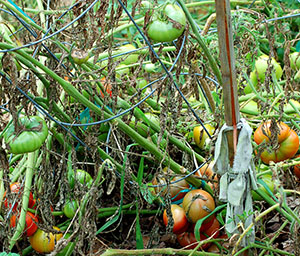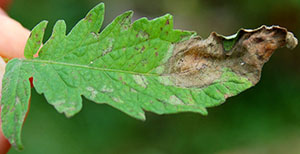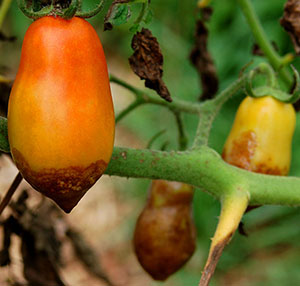Late blight: What does it look like?
If your tomato crop failed miserably in the summer of 2009, take heart, you are not alone. Thousands of people faced the same disaster. And it doesn’t mean you’re a failure as a gardener. A widespread fungus disease called late blight caused the problem and cool, wet weather made it worse.
How can you tell if your tomatoes are infected with late blight? Check the leaves and stems for large brown spots, look for cottony white spores on the spots, and see if the fruit has greasy brown patches. The combination of all three symptoms identifies late blight.
Large brown spots.
First, determine the size and color of the spots. Late blight has large spots that grow rapidly, enlarging to engulf the leaf or stem in just a few days. As long as the leaf tissue is moist the spots will be very dark, purplish-black. When the tissue dries out the spots become dark brown. If you see dark brown or purplish-black spots on the leaves that are about the size of a quarter and that get significantly larger (seemingly overnight) you should suspect late blight.
Cottony-white mold.
Second, look for cottony-white mold on the spots, especially on the underside of leaves. In dry weather you may not see this white mold on the plant itself, so do a bit of forensic detective work. Put an infected leaf inside a plastic bag with a piece of moistened paper towel, then seal the bag. If it’s late blight, cottony white spores will develop within 12 hours on the tissue inside the plastic bag.
Greasy brown patches.
Third, look for greasy-looking, brown, firm patches on the tomato fruit. These can appear on unripe, green tomatoes as well as ripe, red ones. They are often on the stem end of the fruit but can be anywhere.
The presence of all three of these symptoms (large, dark spots; cottony-white mold; and greasy brown patches on the fruit) confirms the worst; you have late blight. Our next blog, Late blight: How do I fix it?, gives you some tips on how to deal with it.
David Deardorff is a botanist and plant pathologist. Kathryn Wadsworth is a writer and naturalist. Visit their website. They are the authors of “What’s Wrong With My Plant? And How Do I Fix It?” from Timber Press.





Leave a Reply